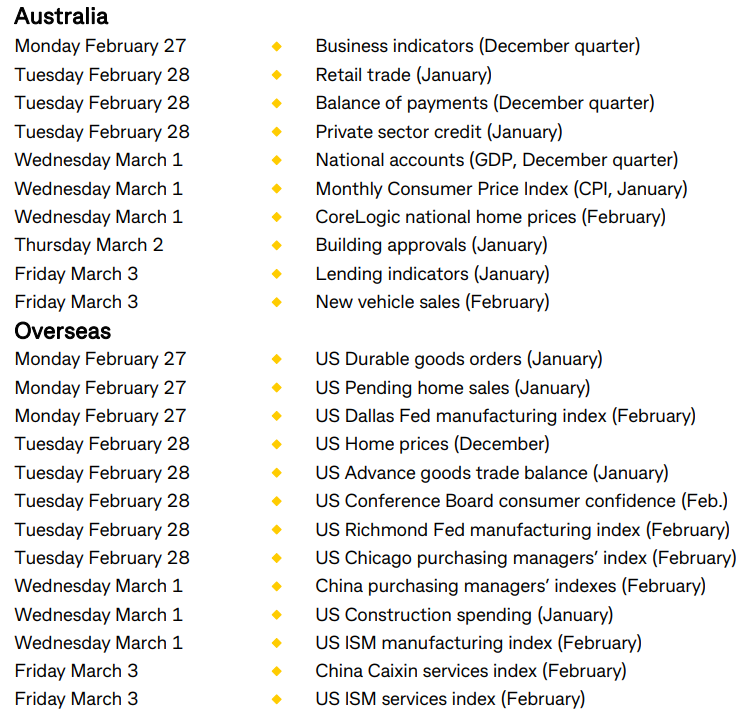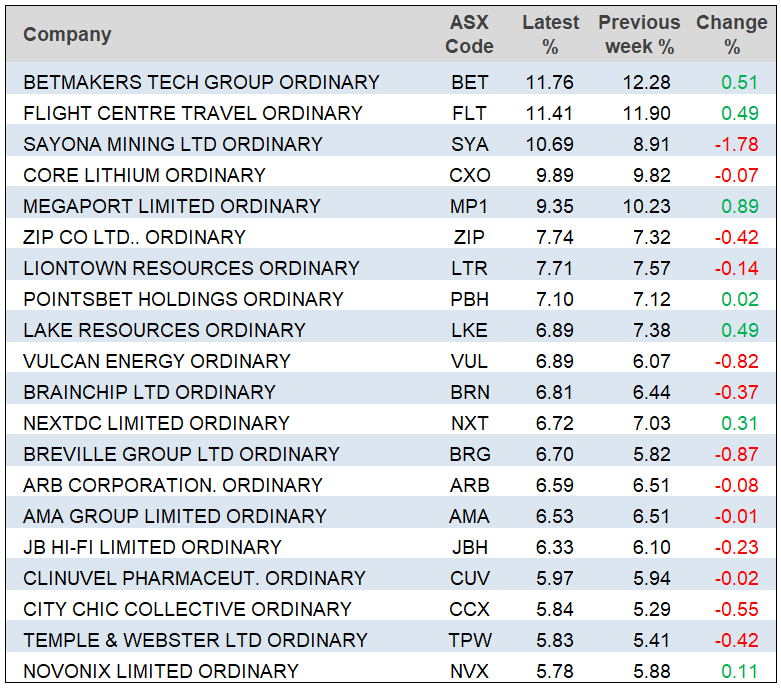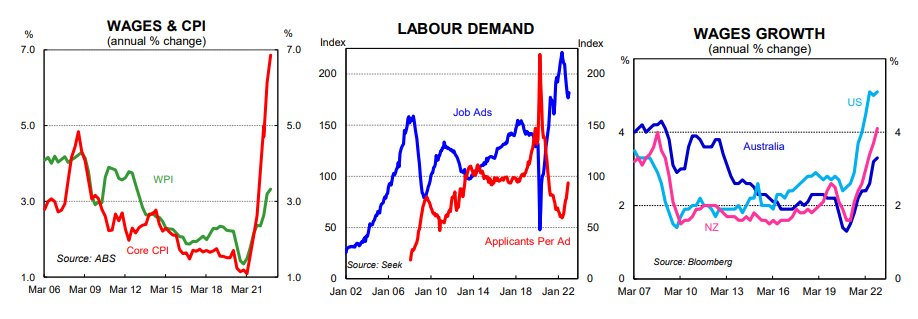
Unfortunately, the US received another inflation indicator — the PCE, or more formally, the personal consumption expenditure price index, which came in higher than expected (and hoped) by the stock market. Even more regrettable, this is the inflation reading that the Fed takes very seriously.
This important reading rose 0.6% in January, taking the annual number for this take on inflation to 4.7%. Now this looks like a much better inflation reading compared to the Consumer Price Index, which is at 6.4%.
So, what has been the reaction? The obvious — stock market indexes are down substantially, bond yields are up, the US dollar is up and the Oz dollar is down to 67.29 US cents, and, of course, tech/growth stocks are on the slide taking the Nasdaq down more than the Dow and the S&P 500.
In case you missed it, it was another mildly negative week across most global share markets, with central banks still putting on the frighteners about future rate rises, with economic data seemingly coming in better than expected. “Share markets also ran up too far in January, so some pull-back from high levels was likely,” observed AMP economist, Diana Mousina. “US markets were down by 1.6% (over the week to Thursday) and are around 16% below their 2021 highs. Australia was 0.5% lower and 4% below its record highs, Eurozone shares were 0.4% lower but are only around 3% below their record highs.”
If you’re wondering why resource and energy stocks aren’t as popular as they were, well, oil prices fell to $82 a barrel for WTI, gas prices are 41% lower than a year ago. “Global commodity prices have fallen by around 22% from their 2022 highs, which is leading to a fall in food prices and will lead to lower food inflation,” Diana pointed out.
Only good old iron ore keeps on delivering, with prices at $121 a tonne. Other metals like aluminium and copper are also higher.
These charts below show that both the local and US stock markets aren’t panicking and look like they’re playing a ‘wait-and-see’ game with the flow of economic data.

Our market is up 5.19% year-to-date and down 3.7% since inflation came in higher than expected at 1.9% for the December quarter and 7.8% for the year.

The US market is off 3.9% since its inflation dropping story was less convincing in February.
So why isn’t the central bank rhetoric really spooking stock markets? Well, try these observations:
- In the US, the February FOMC meeting minutes showed relatively little disagreement amongst members around hiking by a softer 0.25%.
- The market expects two more rate rises and seemingly could cope with that.
- US March quarter earnings are close to wrapping up, with 93% of companies finished reporting results. Around 69% of earnings have surprised on the upside, compared to a historical average of 76% and earnings growth is still running around -2% compared to a year ago. This wasn’t disastrous suggesting a recession is around the corner.
- December quarter GDP was revised down to 2.7%, annualised from 2.9% previously because of weaker consumer spending, weekly jobless and continuing claims fell again and January existing home sales declined in January.
Remember this: AMP’s investing/economics team says the following. First, global shares are expected to return around 7% this year and second, “Australian shares are likely to outperform again, helped by stronger economic growth than in other developed countries and ultimately stronger growth in China supporting commodity prices and as investors continue to like the grossed-up dividend yield of around 5.5%. Expect the ASX 200 to end 2023 at around 7600.”
That’s 4.1% in capital gain plus 4% to in 5% dividends. You can also add in franking credits. This is why I expect at least 10% this year, but if the Yanks have a tech sector rebound, the gain will be bigger there and here.
That was my confident position until that damn PCE reading, which adds weight to the argument that US inflation will be stickier than the stock market consensus believed and hoped. This means the Fed could raise interest rates harder than the market expected. They also might do it longer, making the chances of a deeper-than-tipped recession more of a chance.
More recession worriers will join the inflation worriers, who’ll grow in numbers and work against stock prices going higher, until inflation data shows previous rate rises are actually working.
To the local story this week and the S&P/ASX 200 Index lost nearly 40 points (or 0.54%) this week to finish at 7307, with long-term disappointment, Brambles, putting in a good report and it raised its dividend. And even Block (which now has Afterpay) impressed the market rising 5.8% on Friday to $115.31.
Here are the big winners and losers of the week:

This looks like a big story in the AFR: “Pilbara Minerals has declared its maiden dividend of 11¢ a share following its $1.24 billion first-half profit. It added 1.1 per cent to $4.53.”
What I liked
- Capital expenditure by business was OK and doesn’t indicate anything that looks like a prelude to a recession. This is how CBA’s economics team saw it: “The lift in 2023/24 investment plans is positive for a raft of companies in the Industrials sector as well as a number in Materials.And solid business spending will also keep the economy more broadly supported in the expected challenging environment from July.”
- The Wage Price Index (WPI) rose by 0.8% a quarter in the fourth quarter of 2022 and the annual rate stepped up to 3.3%. Private sector wages grew by 0.8%, while public sector wages rose by 0.7% over the quarter. This softer wages index lends weight to the case that the RBA should pause very soon in the tightening cycle.
- The Australian composite PMIrose to 49.2 in February, from 48.5,although it is still below 50, which means that activity is contracting.
- In the US, job advertisements and mortgage applications declined, which is good for helping the Fed ease up on rate rises.
- PMI price measures showed a decline in input prices, which suggest the supply chain inflation is dissipating.
What I didn’t like
- The RBA Board minutes, which told us that either a 25 basis points or 50 basis points hike was considered at the February Board Meeting that made economists think two more 0.25% rises still lie ahead. I think we’ve had enough.
- Westpac chief economist Bill Evans increased his forecast for the RBA’s terminal rate to 4.1% from 3.85%. “Our new forecasts now have Australia’s tightening cycle peaking around six weeks before the US cycle. (AFR) Thankfully, great economists like Bill can be wrong but we economists seldom rub it in because it’s a tough gig guessing the economy and what the RBA might rightfully and wrongfully do!
- This from the CBA’s Gareth Aird: “The profit-reporting season has been underwhelming so far, with no real consistent themes except that an uncertain environment lies ahead in terms of interest rates, impact on inflation and impact on the economy.”
- Global PMI’s improved in February, confirming other signs that the global economy was hotter than expected at the start of the year, which is not good for killing inflation and rate rises.
What economic data will be watched this week?
The US is the main game for stocks and the Oz dollar, so I’ll be watching US durable goods to see if production is slowing, home prices, consumer confidence, construction and the ISM manufacturing index. While home prices and consumer confidence will have a bearing on what the market thinks about inflation, the other numbers will give a view of how fast the US economy is slowing and that in turn has an inflation implication.
Locally it’s a big week, with retail trade for January and the December quarter economic growth reading. That’s on Wednesday. On the same day we get the monthly CPI, which while not as respected as the quarterly inflation stat, the trend will be looked at closely by the market.
Then on Thursday we see home prices and building approvals, which the RBA will want to see that previous rate rises are working to slow down buyer enthusiasm to pay high prices for bricks and mortar.
The market will also be keen to see the Chinese data out later in the week.
“In China, all eyes will be on the official government and Caixin high-frequency purchasing managers’ indexes for February,” CommSec’s Craig James observed. “Economists and investors will be looking for a ‘re-opening’ bounce in services activity around the Lunar New Year period. That said, extended post-Covid holidays could subdue activity in the manufacturing sector.”
I’ve said it and so have central bank bosses — we’re all watching the data drops and until inflation is beaten, stock markets will be more negative than positive. However, when inflation is down for the count, stocks will surge and the Oz dollar will spike but you have to hope that we don’t have to endure a bad recession before the good times roll.
The week in review:
- In this week’s Switzer Report, I talk about how you can play this stock market twilight zone, It seems like we’re in a stock market twilight zone and it’s hard to be categorical about whether this current trading period is a prelude to another leg up or another leg down. Here are my thoughts…
- The headline in The Australian Financial Review last Thursday summarised how many in the market were feeling in regard to CBA’s half year profit result – “as good as it gets”. Paul Rickard takes a closer look and asks: “has CBA’s share price peaked?”
- Tony Featherstone shows you two companies he thinks will be good to watch in this business-to-business arena. Tony thinks AUB Group and Judo Capital Holdings are well placed for growth. Both stocks suit long-term investors.
- James Dunn shows you two great stocks that he found for under 10 cents, Can there possibly be good buying in single-digit share prices? James has been trawling through the ASX-listed population looking for this kind of situation, and here are two single-digit share prices that he thinks fit the bill
- Shane Oliver joins us in the Switzer Report this week, in his article Shane goes into 8 charts he thinks all investors need to look at, here are charts investors need to look at and understand what they’re saying. These charts reinforce Shane’s views on investing this year.
- For our “HOT” stock, Raymond Chan, Head of Asian Desk at Morgans explains that there are 4 key reasons why he likes Telstra (TLS). Plus Michael Gable, Managing Director of Fairmont Equities, says that Fortescue Metals (FMG) is likely to begin the next phase of its uptrend.
- In Buy, Hold, Sell – Brokers Say, there were 15 upgrades and 17 downgrades in the first edition and 20 upgrades and 15 downgrades in the second edition.
- And finally, In Paul Rickard’s Questions of the Week, Are coal stocks a buy? I am going into a retirement village and just want managed funds – which fund would you recommend? Why isn’t Origin Energy trading closer to the new takeover price of $8.90? What is the last day to buy BHP shares to get the dividend, and when will this be paid?
Our videos of the week:
- Why stocks could surge or slide this week | Switzer Daily
- What do the charts say about the us market? Reporting season hits and misses! | SwitzerTV
- Boom! Doom! Zoom! | 23rd February 2023
Top Stocks – how they fared:
The Week Ahead:

Food for thought: “Accepting losses is the most important single investment device to ensure safety of capital.” – Gerald M. Loeb
Stocks shorted:

ASIC releases data daily on the major short positions in the market. These are the stocks with the highest proportion of their ordinary shares that have been sold short, which could suggest investors are expecting the price to come down. The table shows how this has changed compared to the week before.
Chart of the week
Wage increases in the private sector have continued to outpace the public sector over recent quarters, albeit the quarterly growth rates have converged. The 0.8%/qtr increase in private sector wages took the annual rate to 3.6%. Public sector wages increased by 0.7%/qtr over Q4 22 and the annual rate stepped up a touch to 2.5%. Wage increases for public servants have been held down by long standing wages caps. But many of these are currently now being revised higher.
The WPI including bonuses stepped down to 3.5% (from 3.8% in Q3 22). The data is not seasonally adjusted so we don’t focus on the quarterly read and it is the annual rate that matters. Over the past year firms have made greater use of bonuses and discretionary payments rather than adjusting base pay upwards. Such an approach avoids ‘locking in’ higher pay. This is very important when considering the outlook for inflation. Firms that have used bonuses and other one off payments to reward, retain and attract workers rather than upwardly adjusting base pay have not had a permanent upward adjustment in input costs. As demand in the economy slows these payments can be wound back. A wage-price spiral occurs when base pay is resetting upwards in line with inflation, not when greater use of discretionary payments are made when the economy has boomed and the labour market was tight, as was the case in 2022.

The WPI has its limitations. And it is not the only measure of labour costs. But the WPI is still the benchmark for wages growth in Australia. It enables us to better understand what is occurring across the whole economy with respect to wages inflation in a way that most of the other survey measures of labour costs do not (they are influenced by changes in superannuation, headcount, hours worked, absenteeism, job shifting, promotions and discretionary payments). We retain our base case that the annual rate of wages growth will peak at 3.8% in mid-2023. We do not share the RBA’s central scenario that the annual rate of wages growth will lift to 4.2%. As such, we expect inflation to subside more quickly than the RBA. – Craig James, Commsec Research
Important: This content has been prepared without taking account of the objectives, financial situation or needs of any particular individual. It does not constitute formal advice. Consider the appropriateness of the information in regards to your circumstances

